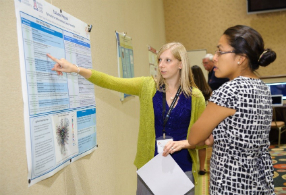The Partnership for Native American Cancer Prevention (NACP) model
Authors: Robert T. Trotter II, PhD, Kelly Laurila, MA, Dave Alberts, MD, Laura F. Huenneke PhD
PMID:25265164 [PubMed – indexed for MEDLINE]
PMCID:PMC4293028 [Available on 2016-02-01]
The Partnership for Native American Cancer Prevention (NACP) is a partnership between Northern Arizona University and the University of Arizona Cancer Center. Partnerships have high failure rates; research indicates that 60-80% of voluntary partnerships fail for a variety of reasons. Cross-organizational programs like NACP often run into silo issues and the problems due to significantly different organizational cultures including different goals, objectives, rewards, and assumptions. We have paired a classic evaluation model (tracking program processes, outcomes & impacts) which allow us to evaluate progress towards program goals and objectives with advances in community engaged model derived from industry–university partnership models. This coupled approach allows the evaluation team to provide “near real time” feedback to the program to identify issues and offer possible solutions.
Understanding how the NACP partnership works is critical to NACP’s long-term success. To better understand and evaluate the NACP partnership we developed a program specific questionnaire provides additional evaluation data that allows us to understand how the partnership structure changes through time and identify areas for improvement. The partnership questionnaire asks questions about joint work (collaborations), communication, cooperation, conflict, and trust. These can be analyzed, which allows for better feedback regarding key players in the partnership, identifies places where there may be fragmentation occurring and provides understanding of the critical roles that key players have in developing and maintaining a strong partnership.
Providing rapid feedback to the program is an important element of the evaluation process. The evaluation team provides quarterly reports to the program in addition to meeting regularly with NACP staff and attending NACP meetings and events. Evaluation reporting highlight progress towards the NACP’s Training, Research and Outreach components goals and objectives showing change through time, as well as areas that are exceling and areas for improvement.
Evaluation data has also been utilized to better understand the strategies for successful navigation of research training opportunities of Native American students to meeting career goals. Increased graduation rates of students participating in training programs (63 percent of Native American students who participate in NACP received bachelor’s degrees compared to the national average of 38 percent). Our findings include: (1) a web of support and multiple opportunities ensures higher success for Native American undergraduates than a traditional pipeline approach to training; (2) multiple entry points into research training opportunities helps address the unique needs of Native-American students; (3) engaged mentoring and chances for students to learn about careers or graduate programs are critical for the success of Native American students.

